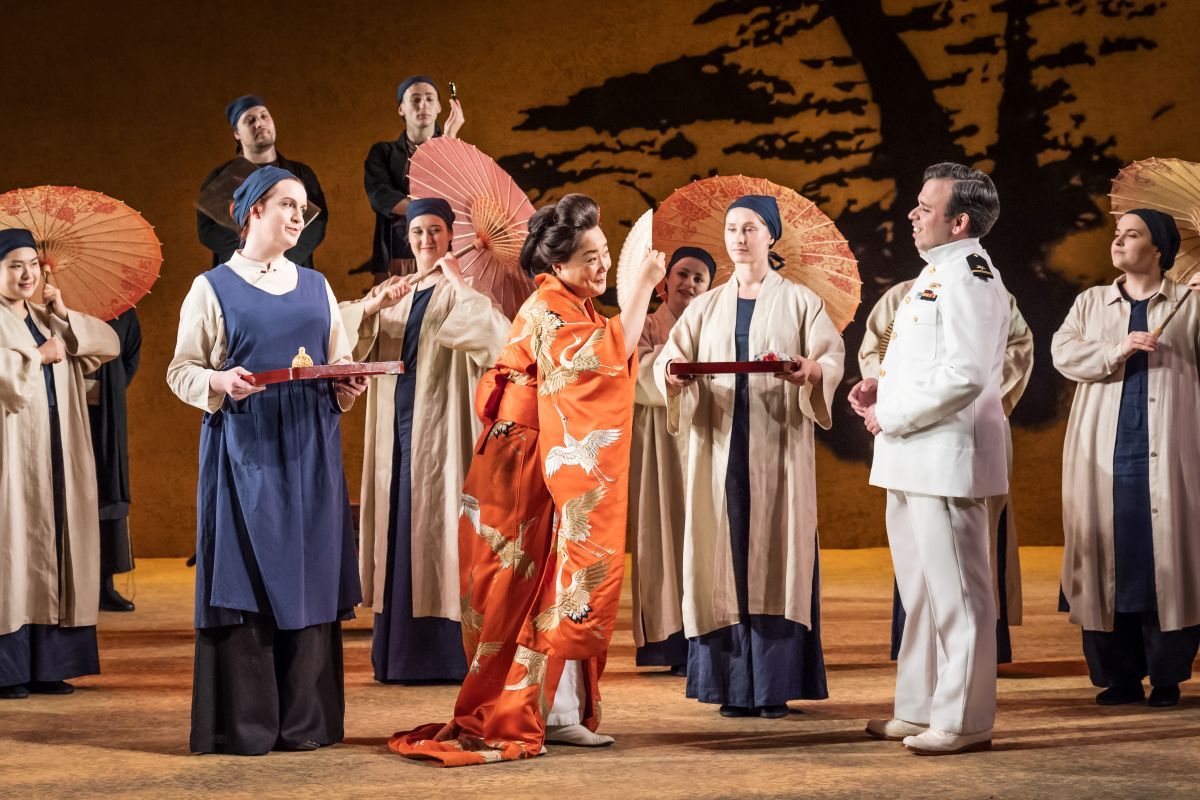This opera may be one of Puccini’s finest musically but the story is centred on another of his doomed heroines – in this case, the young daughter of a Japanese family that has fallen on hard times. After unpopular premieres in 1904, Puccini revised the opera and in 1907 the final successful version was first performed. The story is far from romantic: an American naval lieutenant “marries” a gullible fifteen-year-old Japanese girl and betrays her trust. For the opera to truly resonate, it requires a compelling chemistry between Butterfly and Pinkerton – without it, the piece risks feeling tawdry.
This production at Grange Park Opera feels like a show of two halves, only truly coming alive once the tragic arc gains momentum.
Lieutenant Pinkerton decides to marry the beautiful but naïve Butterfly and to enjoy her companionship for the time he is stationed in Nagasaki. He assumes that, when he leaves, the marriage will end but Butterfly appears to believe that the marriage will be in line with American, not Japanese, law. When the second act begins, Pinkerton has been absent for three years but Butterfly continues to believe he will return and to reject other suitors, though she is living in poverty, while raising a son he does not know about. At last his boat appears in the harbour but it transpires that he has an American wife with him. He and his wife offer to take the boy away with them and raise him in America. Butterfly feels she must agree to this for her beloved son’s sake but cannot face life without him.
Puccini was at the height of his powers when he composed Butterfly, following La Bohème and Tosca. In this work, he developed a musical language that evokes a stylised sense of Japan and lends the final scenes a powerful, sorrowful intensity. Crucially, the Act I duet between Pinkerton and Butterfly needs to establish a convincing romantic connection for the opera to work as a whole – but in this production, that essential spark was missing, leaving the drama emotionally underpowered until much later.
Happily that changed in the second act and Lee, with effective musical and dramatic support from Kitty Whately as her devoted servant Suzuki, rose to the challenge of bringing to life Butterfly’s transition from wilfully blind victim to dignified suffering – and as a result the dramatic impact of her singing took on new power. Sadly Gomes didn’t match up to that change and so his less credible transition to a man racked by regret and remorse didn’t convince. As the resident consul Sharpless, Ross Ramgobin cut a hapless figure whose good advice was invariably ignored by Pinkerton – it’s a difficult part to make much of, but he sang with a light and lively tone and a fine sense of an impending tragedy.
Stephen Barlow conducting the Gascoigne Orchestra gave a convincing reading of the fine score but again only found the real fire in the story’s belly in the final scenes. Director John Doyle was also credited with the design. The stage looked good – the three chests and the three bamboo curtains, alongside the tree design, provided a spare but telling setting. The wedding scene was lively and the all-night watch as Butterfly hopes for the return of Pinkerton was beautifully lit and paced. And, despite my caveats about the earlier scenes, the tragic ending, with fine singing from Lee, held all the emotional power that one expects from a good Butterfly. A night of contrasts.
Venue: Grange Park Opera
Composer: Giacomo Puccini
Libretto: Illica and Giacosa
Director: John Doyle
Conductor: Stephen Barlow
Performers incl: Hye-Youn Lee, Luis Gomes, Ross Ramgobin, Kitty Whately
Running time: 3 hours 45 minutes (incl long interval)
Until 6 July
Photographs: Marc Brenner

